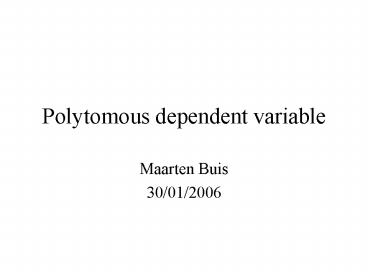Polytomous dependent variable - PowerPoint PPT Presentation
1 / 21
Title:
Polytomous dependent variable
Description:
Polytomous dependent variable. Maarten Buis. 30/01/2006. Recap dichotomous dependent variable ... Polytomous response. example: On the question 'Can you talk ... – PowerPoint PPT presentation
Number of Views:46
Avg rating:3.0/5.0
Title: Polytomous dependent variable
1
Polytomous dependent variable
- Maarten Buis
- 30/01/2006
2
Recap dichotomous dependent variable
- We modeled the relationship between the
probability of an event (e.g. owning a house) and
explanatory variables as an S-shaped curve. - We modeled the relationship between the log odds
of an event versus no event and explanatory
variables as a linear function.
3
Dependent variable is unobserved
- The dependent variable is (a transformation of) a
probability. - We observe whether an event occurs.
- We do not observe probabilities.
- How can we estimate this model?
- Even weirder How can you transform a unobserved
variable?
4
example data
- the model is
- This implies that
5
Maximum Likelihood
- The probability of observing someone with an x of
1 and an y of 0 is - This is the probability of observing person 1
- The probability of observing someone with an x of
3 and an y of 1 is - This is the probability of observing person 3
- The probability of observing both persons 1 and 3
is
6
probability of observing the data
7
likelihood function
- The probability of observing the data is called
the likelihood of the data - In this case it is a function of two parameters
b0 and b1 - Maximum likelihood means find the values of b0
and b1 that maximize the probability of
observing the data. - This is usually done by trying out many values
of b0 and b1
8
(No Transcript)
9
(No Transcript)
10
(No Transcript)
11
Dichotomous response
- Dichotomous response, two options e.g.
- either own or not own a house
- There are two probabilities, so only one odds
the odds of owning a house versus not owning a
house.
12
Polytomous response
- example
- On the question Can you talk about day to day
problems? You can answer no, more-or-less, or
yes. - Only two odds are modeled The odds of can talk
versus cant talk, and the odds of more-or-less
versus cant talk. - Cant talk is the reference category.
13
Two logits
- Create two new variable
- more (1 if more-or-less, 0 if no, sysmis if yes)
- yes (1 if yes, 0 if no, sysmis if more-or-less)
- Fit a logistic regression on each variable
14
two logits
more-or-less versus no
yes versus no
15
One multinomial logit
16
Ordered logit
- Being able to talk about day to day problems
could measure a continuous underlying variable
loneliness. - This unobserved loneliness is cut up in three
pieces. - figure 15.12 on page 477
17
Ordered logit
- Interpreting the Threshold
- Pr(nomale, 55) exp(-1.717)/(1exp(-1.717)) 15
- Pr(more-or-lessmale, 55) exp(-1.117)/(1exp(-1.1
17)) -.15 9 - Pr(yesmale, 55) 1-exp(-1.117)/(1exp(-1.117))
75
18
Interpreting coefficients for female
- The odds of answering no versus more-or-less or
yes for females is exp(-.046).955 times that
odds for males - The odds of answering more-or-less versus yes for
females is exp(-.046).955 times that odds for
males - This odds is the same Proportional Odds
Assumption.
19
Nested Dichotomies
- Allows one to model transition probabilities if
one only end levels are observed. - This is possible because we make an assumption
about which transistions a person must have
passed in order to reach his level of education - This assumption is not straightforward in tracked
systems like the Netherlands.
20
Selection
- Assume the probability of passing a transition
depends on both intelligence and socioeconomic
status, and only SES is observed. - At low transitions only the smart low status kids
pass, while both smart and dumb high status kids
pass.
21
Selection
- At higher transitions the surviving low status
kids will be mostly smart and have a reasonable
chance of making it to the next level. - Thus the observed difference between high and low
status kids in transition probability declines.

